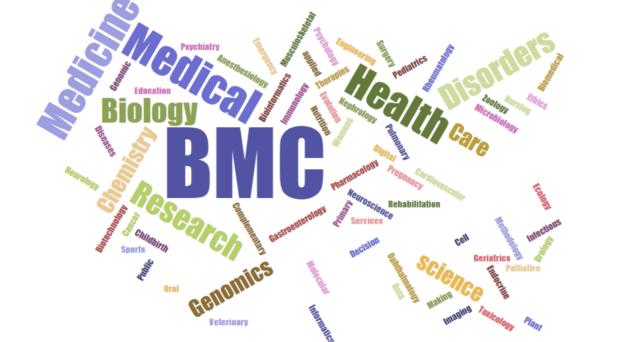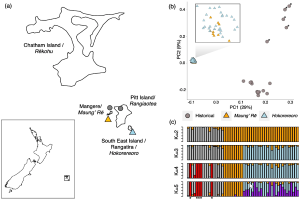
BMC Ecology and Evolution – Land use and soil characteristics affect soil organisms differently from above-ground assemblages
 This week almost 200 countries signed a historic deal at the United Nations Biodiversity Conference (COP15) in Montreal in a big push to halt our planet’s biodiversity loss by 2030. This deal includes plans to restore 30% of earth’s degraded terrestrial, inland water, coastal and marine ecosystems. While this is a great step into the right direction, understanding all parts of ecosystem loss is important to implement the right actions. Soil biodiversity (the variety of organisms that live in soil and leaf litter) has been notoriously underrepresented in biodiversity indicators like the Living Planet Index, despite its fundamental role in soil health, water purification and carbon sequestration.
This week almost 200 countries signed a historic deal at the United Nations Biodiversity Conference (COP15) in Montreal in a big push to halt our planet’s biodiversity loss by 2030. This deal includes plans to restore 30% of earth’s degraded terrestrial, inland water, coastal and marine ecosystems. While this is a great step into the right direction, understanding all parts of ecosystem loss is important to implement the right actions. Soil biodiversity (the variety of organisms that live in soil and leaf litter) has been notoriously underrepresented in biodiversity indicators like the Living Planet Index, despite its fundamental role in soil health, water purification and carbon sequestration.
In this study published in BMC Ecology and Evolution, researchers modelled abundances of above-ground and soil organisms in different land uses and soil properties based on data from the PREDICTS project. This project analyzes ecological data on the human impact – particularly related to land use change and intensification – on changing biodiversity. Their results show that soil biodiversity responds differently to land use than above-ground organisms. For instance, soil biodiversity is much more impacted by high-intensity farming and recovers much more slowly from clear felling and reforestation with different tree species than above-ground organisms.
This study highlights the need to find more sustainable ways to feed a rapidly growing population without impacting soil biodiversity. In addition, off-setting carbon with plantation forests should be weighed against the risk of losing healthy soil biodiversity, required to underpin ecosystem function. More research is needed to understand the complexities of soil biodiversity, ecology, and the interplay between below- and above-ground communities.
BMC Genomics – Genomic trajectories of a near-extinction event in the Chatham Island black robin
 As species extinction accelerates at unprecedented rate, finding reliable ways to protect endangered species has become one of the top priorities of the UN Sustainable Development Goals. Critically endangered species pose a particular challenge as inbreeding in small populations can lead to the accumulation of harmful mutations and reduced fitness. Eventually this may either cause extinction due to a so-called “mutational meltdown” or enhance natural selection by more efficiently reducing harmful mutations in offspring – a process called genetic purging.
As species extinction accelerates at unprecedented rate, finding reliable ways to protect endangered species has become one of the top priorities of the UN Sustainable Development Goals. Critically endangered species pose a particular challenge as inbreeding in small populations can lead to the accumulation of harmful mutations and reduced fitness. Eventually this may either cause extinction due to a so-called “mutational meltdown” or enhance natural selection by more efficiently reducing harmful mutations in offspring – a process called genetic purging.
In this study, published in BMC Genomics, researchers used the critically endangered Chatham Island black robin as a model to obtain insights into the genomic impact of near-extinction events. This bird was driven to near extinction due to habitat fragmentation and introduction of rats, with a population size of 5 individuals in 1976. Conservation efforts managed to increase the population number, with a total of 25 birds in 2021, all of which were descendants of a single breeding pair. Comparing the genome of 52 Chatham Island black robin genomes over the span of 150 years the researchers found evidence of a decrease in genome-wide diversity and an increase in mutational load. Some of the results also support the loss of harmful mutations through genetic purging, which may have been a side-effect of early habitat fragmentation.
The genetic mechanisms described in this paper are important factors to consider in conservation biology and genetic management of threatened species. The authors suggest that when it comes to future conservation efforts, individuals with the lowest mutational load should be selected to maximize breeding success.
BMC Medical Research Methodology – Applying the 4Ps of social marketing to retain and engage participants in longitudinal cohort studies: generation 2 Raine study participant perspectives
 The Raine Study is one of the largest prospective longitudinal cohort studies, established in 1989 in Australia. The aim of this study was to investigate how events during pregnancy and early childhood affect people’s adult health and disease. In the first recruitment phase, 2,900 pregnant women (Generation 1) were included and their resultant 2,868 births were followed up with as Generation 2. Multi-generational long-term studies are invaluable for our understanding of human health and disease and can help shape policies and medical practice further down the line. But how do we retain participants over such a long period of time?
The Raine Study is one of the largest prospective longitudinal cohort studies, established in 1989 in Australia. The aim of this study was to investigate how events during pregnancy and early childhood affect people’s adult health and disease. In the first recruitment phase, 2,900 pregnant women (Generation 1) were included and their resultant 2,868 births were followed up with as Generation 2. Multi-generational long-term studies are invaluable for our understanding of human health and disease and can help shape policies and medical practice further down the line. But how do we retain participants over such a long period of time?
In this qualitative study published in BMC Medical Research Methodology, researchers describe the experience of active and inactive participants of Generation 2 in relation to the so-called 4Ps – Product, Price, Place and Promotion – of social marketing. Social marketing uses commercial marketing principles to influence people’s behaviors for their own or society’s benefit. Based on participant responses, researchers could define the Raine Study’s product as regular health check-ups for participants and the feeling of contributing to the greater good. These beneficial products came at the price of “feeling like a lab rat” and the inconvenience of repeatedly completing surveys and questionnaires. Having to attend the Raine Study headquarters for regular check-ups (place) was mentioned as an inconvenience that could deter participants from actively participating in the study. However, the biggest promotional asset for active members was the feeling of being part of the “Raine Study family” and its associated purpose, prestige, and importance.
The social marketing framework described in this paper illustrates how researchers can create a deeper understanding of how participants perceive cost and benefit accrued through their participation in longitudinal studies. This in turn can help to specifically target these issues and retain participants over a longer period of time.
BMC Pregnancy and Childbirth – The human right to safely give birth: data from 193 countries show that gender equality does affect maternal mortality
 Due to a big effort to improve child survival, numbers of neonatal deaths dropped worldwide by more than 50% over the past 3 decades. In contrast, maternal mortality is still unacceptably high and in the majority of cases completely preventable. Most maternal deaths occur in low-income countries which greatly reflects inequalities in access to appropriate healthcare. But this is only part of the picture. Research has shown that gender inequality plays a major role in maternal health outcomes.
Due to a big effort to improve child survival, numbers of neonatal deaths dropped worldwide by more than 50% over the past 3 decades. In contrast, maternal mortality is still unacceptably high and in the majority of cases completely preventable. Most maternal deaths occur in low-income countries which greatly reflects inequalities in access to appropriate healthcare. But this is only part of the picture. Research has shown that gender inequality plays a major role in maternal health outcomes.
In this article, published in BMC Pregnancy and Childbirth, researchers examine the correlation between gender equality and the reduction of maternal mortality using 512 gender-sensitive variables representing 193 countries. Their results show a clear reduction in the maternal mortality ratio with an increase in gender equality. Female education is an important marker for gender equality and positively influences other crucial factors, including the use of contraception and financial independence. In addition, women in leadership and political positions have an irrefutable impact on maternal health. Not surprisingly, child marriage, intimate partner violence and lack of autonomy have the opposite effect.
This article clearly identifies the variables that play a role in improving maternal health and can be used to monitor progress in this field. Addressing gender equality through women’s education and empowerment are at the forefront of improving maternal health. In addition, the authors recommend reinforcing policies and laws aimed at eliminating child marriage and intimate partner violence.
BMC Medical Ethics – “I don’t think people are ready to trust these algorithms at face value”: trust and the use of machine learning algorithms in the diagnosis of rare disease
 Artificial Intelligence (AI) can be a useful and cost-efficient tool to assist healthcare professionals in medical decision-making. The applications of AI in the medical field are broad and reach from interpreting images in pathology and radiology to identifying patients for clinical trials or analyzing genetic data. While this is a clear advancement for the medical field, an important question remains to be tackled: do we trust medical AI?
Artificial Intelligence (AI) can be a useful and cost-efficient tool to assist healthcare professionals in medical decision-making. The applications of AI in the medical field are broad and reach from interpreting images in pathology and radiology to identifying patients for clinical trials or analyzing genetic data. While this is a clear advancement for the medical field, an important question remains to be tackled: do we trust medical AI?
This qualitative study published in BMC Medical Ethics explores the question of under which conditions we trust AI, from the developers’ and clinical users’ perspective. In this study, researchers interviewed members of the Minerva Initiative, a consortium of commercial, clinical, and academic researchers who work on computational phenotyping using facial recognition algorithms. This study found that trust in the reliability and quality of the tool is crucial from both the clinicians’ and the patients’ side. The tools need to work well and produce reliable and validated results. Over time the clinician’s positive experience will be directly influence the patient’s trust in the AI tools.
This study emphasizes the need for deliberate and meticulous steps in designing trustworthy and confidence-worthy AI processes. The authors suggest that randomized controlled trials or increased transparency would help signify the epistemic trustworthiness of these tools.
Comments